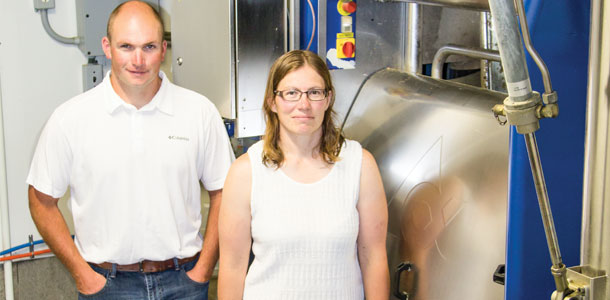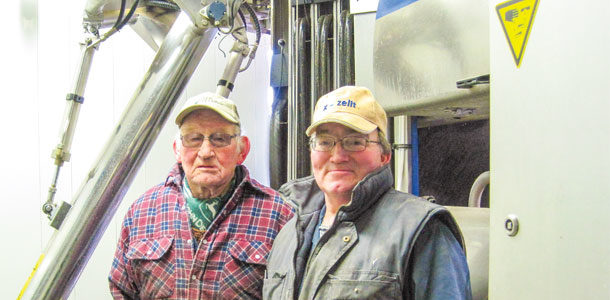The robotic milking boom is bigger and stronger than it has ever been. Currently, in Canada there are approximately 1,600 robotic milking stations in operation.
What I find to be very interesting is that the early adopters are still milking with robots today. Some have bought new versions, and some have been able to upgrade their current model and save the extra cost of a new robot.
What is amazing is that farmers are staying with robotics and have reaped the benefit of hundreds of thousands of milkings over the years. They have saved their legs, shoulders, arms and other parts of their body from the wear and tear of everyday milking.
They have attended family events, hockey games and countless activities that have helped to reshape and improve their lifestyle. The robotic milking world is a good one.
A question I often get asked is: How are these old robots keeping up? How long will they last and how do they compare to newer robots? In the earlier years, we all predicted that new robotic milking systems would last approximately 10 to 15 years.
But now we are wondering how much longer these robots can last. Robots that were installed in 2002 still look brand-new; their shining stainless steel still reflects like the first day it was moved into the barn.
But what is most important is the fact that some robots can be upgraded to new standards so you are not forced to make another large capital investment.
Sometimes these upgrades occur only a short time after you have purchased your product; therefore, being able to upgrade your current model can be a huge advantage.
For example, Tom and Suzanne Pettit installed their robot in 2012. This brother-and-sister pair switched from a 42-head tiestall barn to a brand new 70-by-240-foot, three-row freestall barn, designed specifically for robotics. Their first day of milking in the new barn was on May 15, 2012.
But the fascinating part was: The robot that milked that first cow was already 10 years old. It didn’t look 10 years old. As a matter of fact, it may have been shinier than a brand-new robot. It didn’t act 10 years old. It milked the first cow like it was a brand-new robot.
Assuming this robot milked 50 cows three times per day, this robot has already completed 547,500 milkings in its previous life.
That means Tom and Suzanne’s first milking was approximately milking 547,501 for the robot. Why would someone purchase a product that has already milked more than half a million times? For Tom and Suzanne, it was easy.
Tom and Suzanne attended many open houses and did their research extensively. They wanted to make sure they had the right fit for their barn. They chose a 10-year-old robot for several reasons. Initially, you would have thought the reason was going to be cost.
But when asked the question about their purchase, they quickly reply, “Upgradability.” This had been a huge factor for them when doing their research. The goal was to keep the robot in their barn as long as they could so they could get maximum investment from their purchase.
The robot had been completely upgraded at their local dealership before it was delivered to the barn. Although the robot was 10 years old, it had been given a new life by being upgraded to 2012 model status. The cost of purchase was much cheaper than purchasing a new robot and fit their business plan perfectly.
Tom and Suzanne have been milking for almost three years with their used robot. Since it was installed, two major upgrades have occurred. First, they installed an online somatic cell counter (OCC) – a unit that measures the exact somatic cell count results from every cow in the herd every time she is milked.
This is ideal for early mastitis detection as well as culling decisions when the time is needed. Tom mentions that this is a tool that you do not want to be without.
The second upgrade was a newer camera. The new camera gave the ability to attach faster and more accurately every time a cow came into the robot, creating a lower stall time for the cows. Tom states he is looking forward to future upgrades that will continue to make his robot better than the day he purchased it.
When Tom and Suzanne are asked how long they thought their robot would last, he quickly replies, “I would be very surprised if this robot, the way structurally it is built and with continued upgrades, that it does not see its 25th anniversary.”
This was a huge statement considering many people thought this was a 10- to 15-year investment. This 40-litre-average farm is quite satisfied with its purchase, and the owners look forward to many years milking in their new facility.
Another robotic farmer, Chris Tegenbosch, took a different approach than the Pettits. Opposite of Tom and Suzanne Pettit, Chris installed new robots in a renovated barn. He purchased his brand-new robots in 2005, and although many improvements have occurred over the years,
Chris has made it his goal to keep his robots completely upgraded rather than having to purchase new ones. For Chris, it was about the big picture; he explains, “We were hoping to use our existing barn and install robots that we knew we could upgrade and continually make improvements in a barn that already existed.
Although it would be exciting to get a brand-new robot, it would be very hard for us to justify replacing something that is working hard for us. Our goal is to keep the same robot milking for years to come.”
 Since the robot was installed in 2005, the Tegenbosches have done one complete overhaul, essentially removing the old technology and installing all new electronics and new software.
Since the robot was installed in 2005, the Tegenbosches have done one complete overhaul, essentially removing the old technology and installing all new electronics and new software.
They have also added a steam backflush system, an OCC and are on the list to have a second upgrade completed to add the latest software.
The Tegenbosches have stated that they are happy their robot investment was designed to last so future investments could be used on items like an automatic feed system that was installed in 2012.
With approximately 450 farms across Canada now using robotic milking systems successfully, I think it is fair to say the milking robotic boom is not going to end any time soon. For some, purchasing a brand-new robot every few years will be the way to add improvements.
For others, keeping the same robot and adding upgrades better meets their budget and business model. What we have learned is that 15 years after the first robots were installed in Canada, some have been built to last much longer than ever anticipated.
It is exciting and reassuring to know there continues to be a strong market for used robots because of the relatively low cost to upgrade and to know the used robot you put in your barn will be there for many years to come.
An industry partner once asked me “Why you would upgrade an old robot?” I replied, “It is up to farmers to decide what fits their budget when they first make their capital investment and what their plans are for the future.
Some will purchase a robot knowing that they will have to purchase a completely new system in five to 10 years, while others want to know the product they purchased will be functional and upgradable for years to come.”
Either way, the market is incredibly strong no matter which direction a farmer decides to proceed. Dirk Molenaar, salesman for Norwell Dairy Systems, explains, “If we are able to land a used robot, that robot will not be in our warehouse for long.
The market is huge for used robots that can be upgraded. The problem is they are getting harder to find because they can be upgraded.”
In the next 10 years, we will see more and more advancements in automated milking. When looking for robots, do not be afraid to look at a used robot if it fits your business plan. Ask questions about how it can be upgraded when you purchase it and how it can continue to be upgraded in the coming years.
We now know 15 years after the first milking robots were installed that some of these robots were built to last. Maybe your new robots will last more than 25 years. PD
PHOTOS
TOP: Chris and Case Tegenbosch of Boschlea Holsteins Inc. purchased brand-new robots in 2005 and have since done a complete system overhaul to keep them operating well for years to come.
BOTTOM: Brother and sister Tom and Suzanne Pettit of Mistyglen Holsteins opted to install a used robot which had been completely upgraded at their local dealership before arriving at their farm. Photos courtesy of Norwell Dairy Systems.

-
Dean Miller
- Milking Robot Product Manager
- Norwell Dairy Systems
- Email Dean Miller










